I'm working on a project in which I must send audio over RF such that remote speakers can pick up the signal around a house/apartment. The goal is to broadcast music from a single device somewhere in the house to multiple speakers without the overhead/limitations/tedium of Bluetooth/WiFi. My current approach is as follows:
- Input mono audio from 3.5mm barrel audio jack to transmitter
- Create 200KHz triangle wave using ADA4851 op amps
- Modulate audio using triangle wave, resulting in 200kHz PWM
- Transmit PWM using FS1000A 433MHz RF transmitter module
- On one or more remote devices, receive RF signal using MX-RM-5V receiver module
- Use BU4S584G2 inverter to produce complementary PWM signal
- Use 2x FAN73932 gate drivers to drive MOSFET H-bridge using the complementary PWM signals
- Filter the H-bridge output using LC low-pass and connect speaker to its output
My main issue at the moment is that I didn't realize the RF modules have such a slow datarate: only around 4-10kbps. So, I need a new RF module with the following characteristics:
- Cheap (can't justify using xBees, plus I don't know if xBees can emulate a wire, or if they must use a serial protocol)
- Data rate at least 2Mbps (minimum pulse width must allow for wide PWM range)
- Range of at least 100ft indoors to reach a whole house
- Only need one-way broadcast in a star network
I'm open to other options, too. I chose PWM so I could use the digital RF modules without needing to encode/decode a binary audio stream. I would rather avoid the hassle of programming microcontrollers at either end. Please offer any suggestions you may have, but my particular interest is finding an equivalent (but faster) RF link.
Thank you, all!
